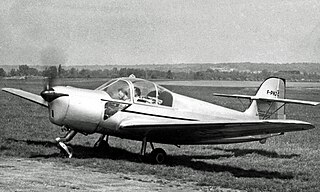Scintex Aviation S.A. was a French aircraft manufacturer which was active between 1956 and 1964.
Contents
- Formation
- Aircraft production
- Scintex own aircraft designs
- Cessation of aircraft production
- References

Scintex Aviation S.A. was a French aircraft manufacturer which was active between 1956 and 1964.

Scintex was formed in 1956 by Jean-Michel Vernhes and a production line was established to build the Piel CP.301 Emeraude, designed by Claude Piel, initially as the CP.30, under licence for French club and private owners. [1]
The Scintex version of the Emeraude was the standard design with upward-opening cabin doors. From 1960 the CP.301C version was introduced, and this incorporated a single-piece clearview sliding canopy. [2]
Claude Piel, who had worked for SCANOR (Societe de Constructions Aeronautiques du Nord), which built Emeraudes, joined Scintex in 1959 and the company introduced the CP.1310 Super Emeraude which first flew on 20 April 1962 and incorporated a strengthened airframe for elementary aerobatics and a generally cleaned-up layout. [3] The majority of the Scintex Emeraudes and Super Emeraudes were built at the Menavia factory at Clermont-Ferrand, but the CP.320 version was intended for construction by amateurs. [4]
In the early 1960s, Scintex wished to broaden its line of aircraft and flew the ML 145 Rubis four-seat touring aircraft on 24 May 1961. [5] This was developed into the Scintex ML 250 Rubis which first flew on 3 June 1962. The improved Rubis had a more powerful engine and was equipped with five seats. Competition from established all-metal aircraft such as the Beech 35 Bonanza resulted in only eight Rubis being completed.
With the lack of sales success with the Rubis, Scintex abandoned aircraft production in late 1964. At the same time, the firm subcontracted construction of all Super Emeraudes to CAARP at Beynes-Thiverval airfield near Paris and in due course CAARP built the aircraft in its own right. [6]

Sud Aviation was a French state-owned aircraft manufacturer, originating from the merger of Sud-Est and Sud-Ouest on 1 March 1957. Both companies had been formed from smaller privately owned corporations that had been nationalized into six regional design and manufacturing pools just prior to the Second World War.

The Aérospatiale N 262 is a French twin-turboprop high-wing airliner built first by Nord Aviation. The aircraft was also known as the Nord 262.
Claude Piel was a notable French aircraft designer.

The Cessna Model 411 is an American twin-engined, propeller-driven light aircraft built by Cessna Aircraft. It was that company's largest business aircraft to enter production when it first flew in 1962.

The Mudry CAP 10 is a two-seat training aerobatic aircraft first built in 1970 and still in production in 2007. The plane was developed from the Piel Super Emeraude and was born as the CP100. The name changed to CAP 10, CAP for 'Constructions Aéronautiques Parisiennes'. The CAP 10 was manufactured by Mudry in Bernay, France, bought by CAP Industries which then became Apex Aircraft. Following the bankruptcy of Apex in 2008, rights to produce spares were awarded to Dyn'Aviation. After the bankruptcy of DynAero in 2012, manufacture of spares was taken over by CEAPR in Darois.

The Piel CP-30 Emeraude is an aircraft designed in France in the mid-1950s and widely built both by factories and homebuilders.
The Continental IO-346 engine is a fuel-injected four-cylinder aircraft engine that was developed especially for the Beechcraft Musketeer Custom III by Continental Motors. It was produced for that aircraft between 1965 and 1969.

The Piel CP.70 Beryl is a French twin-seat, single-engine sport aircraft designed by Claude Piel. It was first flown in France in the 1960s and marketed for amateur construction.
The Piel CP.90 Pinocchio II was a single-seat, single-engine aerobatic sport aircraft developed in France and marketed for homebuilding. The design was based on that of Piel's Emeraude and was unrelated to Piel's first design named Pinocchio, the CP.10 and indirectly to the second, the CP.20. It was a cantilever, low-wing monoplane of conventional design with an enclosed cockpit and fixed, tailwheel undercarriage. Construction was of wood throughout.

The Piel CP.60 Diamant is a single-engine light aircraft designed in France in the 1960s and marketed for home building.

The Scintex ML 250 Rubis was a French civil utility aircraft of the 1960s.

The SIPA S.1000 Coccinelle was a French-built light civil utility aircraft of the 1950s.

The Urban Air Samba is a Czech designed and built light aircraft of the 1990s which incorporates composite construction. It remained in series production in 2017.

The Morane-Saulnier MS.603 was a French-built two-seat light aircraft of the late 1940s.

The Hall Cherokee II is an American high-wing, single seat glider that was designed by Stan Hall and introduced in 1956 as plans for amateur construction.
The Piel CP-10 was a post-war French sports aircraft in the Pou du Ciel tradition and was the first design from Claude Piel to fly.
Asso Aerei Srl is an Italian designer of light and ultralight aircraft founded by Giuseppe (Bepi) Vidor. Vidor was a carpenter who studied engineering at night school, and all his aircraft are wooden designs, most with tricycle landing gear. The aircraft are homebuilt from plans or from very basic kits. The name Vidor Asso is also used.
Marcel Jurca, was a prolific designer of homebuilt aircraft in France. He is most well known for his Tempête and Sirocco designs.
| Wikimedia Commons has media related to Scintex . |